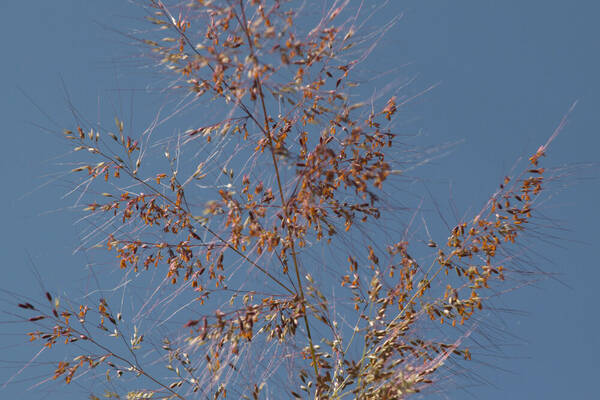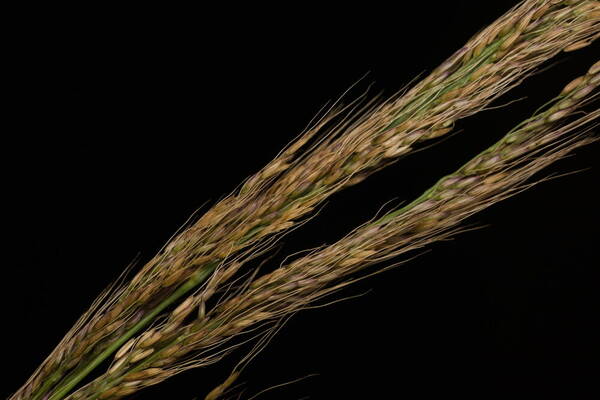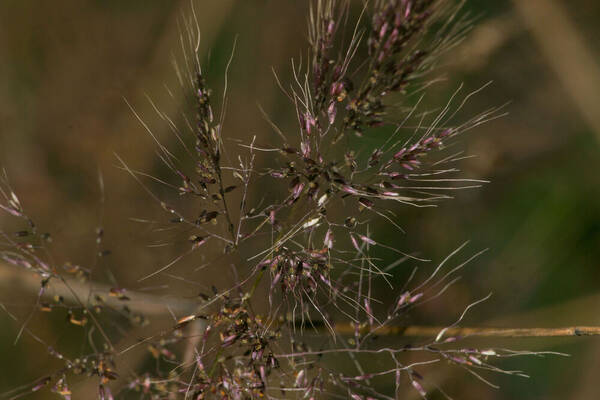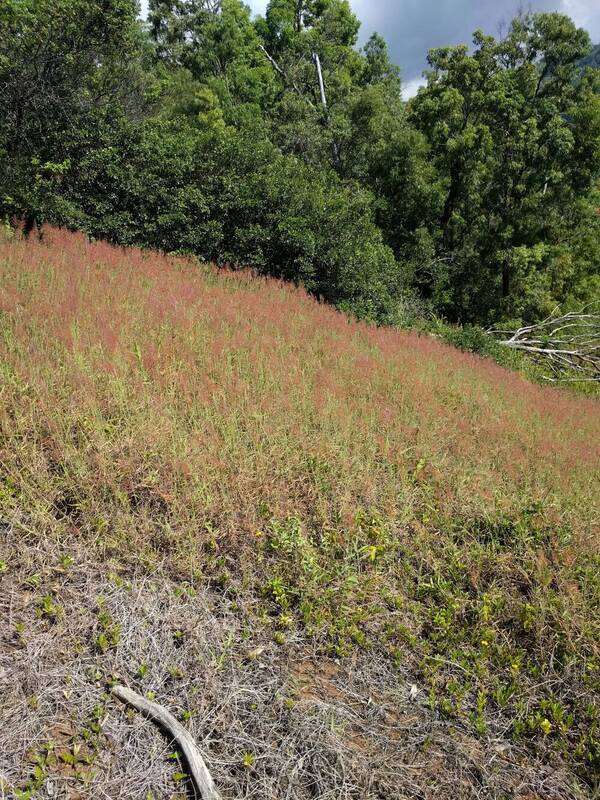Info
Subfamily: Panicoideae
Genus etymology: Melinis = Greek, derivation obscure: either from meline, resembling millet, Panicum miliaceum L., or from melas, because the caryopses are sometimes black, or from meli, honey, because of the sweet smell of some species
Species etymology: minutiflora = "many flowers" [Latin] refering to it having more spikelets than related species
Photosynthetic type: C4 (warm season)
Nativity: naturalized - intentional
First recorded in Hawaiʻi: 1913
Map


Inflorescence






Plant



Habit



Spikelets






Landscape


Collar

Description
Perennial; culms ascending, often matted, up to about 1 m. high. Leaf-blades flat, 5–20 cm. long, 3–11 mm. wide, the blades and sheaths tomentose with hairs which are often sticky and sometimes smelling strongly of linseed oil. Panicle lanceolate to narrowly ovate, 10–30 cm. long, dense, often purplish; pedicels scaberulous (very rarely with a few long hairs). Spikelets narrowly oblong, 1.5–2(–2.4) mm. long, glabrous or sometimes hairy; lower glume sometimes almost suppressed, but usually a little oblong scale 0.2–0.5 mm. long; upper glume straight on the back, prominently 7-nerved, these forming raised ribs, obtusely bilobed, with or without a mucro up to 0.5 mm. long; lower floret barren without a palea, the lemma 5-nerved, these forming ribs, acutely bilobed, with an awn up to 15 mm. long or sometimes awnless; upper lemma as long as the palea. Fig. 124.
(Description source: Clayton, W.D. & Renvoize, S.A. 1982. Flora of Tropical East Africa. Gramineae (Part 3). A.A. Balkema, Rotterdam. 448 pp. )
Perennial up to 100 cm high, ascending; leaves sometimes smelling strongly of linseed oil. Panicle lanceolate to narrowly ovate, 10–30 cm long, dense, often purplish. Spikelets narrowly oblong, 1.5–2(–2.4) mm long, glabrous or sometimes thinly hairy; lower glume sometimes almost suppressed, but usually an oblong scale 0.2–0.5 mm long, not distant from the upper; upper glume straight on the back, prominently 7-nerved, the nerves forming raised ribs, obtusely bilobed, with or without a mucro up to 0.5 mm long; lower lemma 5-nerved, the nerves forming raised ribs, acutely bilobed, with an awn up to 15 mm long or sometimes awnless.
(Description source: Cope, T.A, (1995) Flora Somalia, Vol 4. Royal Botanical Gardens, Kew, London. 312 pp. )
Tufted perennial. Culms (50)80–150 cm. high, ascending. Leaf laminae (2)4–20 cm. long, (2.5)5–11(19) mm. wide, flat, these and the sheaths densely tomentose and usually sticky with a strong smell of linseed oil. Panicle (8)10–20(36) cm. long, narrowly ovate. Pedicels glabrous, rarely with a few hairs towards the apex, scabrous. Spikelets (1.5)1.7– 2.2(2.4) mm. long, narrowly ovate to narrowly oblong. Inferior glume 0.1–0.4 mm. long, ovate, 0–1-nerved, inserted close to the superior; superior glume prominently 7-nerved, awnless or with a short mucro (rarely conspicuously awned), membranous, obtusely bilobed, glabrous, rarely hairy. Inferior floret barren without a palea, its lemma prominently 5-nerved, acutely bilobed, equalling the superior glume but narrower, awnless or with an awn up to 14 mm. long.
(Description source: Launert, E. & Pope, G.V. (eds.). 1989. Flora Zambesiaca. Volume 10. Part 3. Kew, London. 152 pp. )
Plants perennial; cespitose; aromatic. Culms (50)80-150 cm, branching and sprawling, often becoming matted, usually rooting at the lower nodes; upper nodes appressed pubescent; internodes glabrous basally, appressed pubescent distally. Sheaths densely tomentose, hairs 0.5-5.2 mm, spreading, papillose-based, often sticky and smelling of linseed oil; ligules of hairs, 1-2 mm; blades 3.5-19 cm long, 4-14 mm wide, flat, pubescent, hairs sometimes papillose-based. Panicles (4.5)7-20 cm long, 1-9.5 cm wide, narrowly ovate; primary branches to 8 cm; pedicels usually shorter than the spikelets, glabrous, scabridulous. Spikelets 1.7-2.4 mm, usually purplish; calluses glabrous. Lower glumes absent or to 0.3 mm, glabrous, scabridulous; upper glumes 1.6-2.4 mm, glabrous, unawned, sometimes muticous; lower florets sterile; lower lemmas bilobed, lobes 0.2-0.7 mm, unawned or awned, awns to 18 mm; lower paleas absent; upper lemmas 1.4-1.9 mm, glabrous; upper paleas 1.5-1.9 mm, usually slightly longer than the upper lemmas; anthers 3, 1-1.5 mm, reddish-brown to orange. Caryopses 0.9-1.2 mm long, 0.3-0.4 mm wide. 2n = 36.
(Description source: Barkworth, M.E., Capels, K.M., Long, S. & Piep, M.B. (eds.) 2003. Flora of North America, north of Mexico. Volume 25. Magnoliophyta: Commelinidae (in part): Poaceae, Part 2. Oxford University Press, New York. 783 pp http://floranorthamerica.org/Melinis_minutiflora )
Strong-smelling perennials; culms ascending, decumbent at base and branching often, up to 10 dm tall. Leaves viscid pubescent; sheaths often sticky, tomentose; ligule a row of hairs 0.5-1 mm long; blades flat, 10-25 cm long, 3-11 mm wide. Panicles dense, often purple-tinged, lanceoloid to narrowly ovoid, 10-30 cm long, pedicels scaberulous, rarely with a few long hairs; spikelets narrowly oblong, 1.5-2(-2.4) mm long, glabrous or sometimes pubescent; first glume vestigial, represented by a minute oblong scale 0.2-0.5 mm long, second glume purple to green, 2-2.5 mm long, prominently 7-nerved, the nerves raised, apex obtuse, bifid, + with a mucro up to 0.5 mm long; first floret reduced to a lemma, the lemma purple to green, linear, ca. 2 mm long, 5-nerved, the nerves raised, apex bifid, awn scabrous, arising from the midnerve, 10-15 mm long; second lemma enclosing the palea, whitish green to pale green, coriaceous, linear, 1.6-1.8 mm long, 5-nerved, nerves raised, glabrous, apex acute, minutely bifid, + awned from between the lobes, the awn up to 15 mm long; second palea similar to second lemma in shape, size, and appearance. Caryopsis not observed and often undeveloped. [2n = 36, 40.]
(Description source: O’Connor, P.J. 1990. Poaceae, pp. 1481–1604. In: Wagner W.L., Herbst D.R. & Sohmer S.H. (eds.)., Manual of the flowering plant of Hawaiʻi. Vol. 2. University of Hawaii Press & Bishop Museum Press, Honolulu )